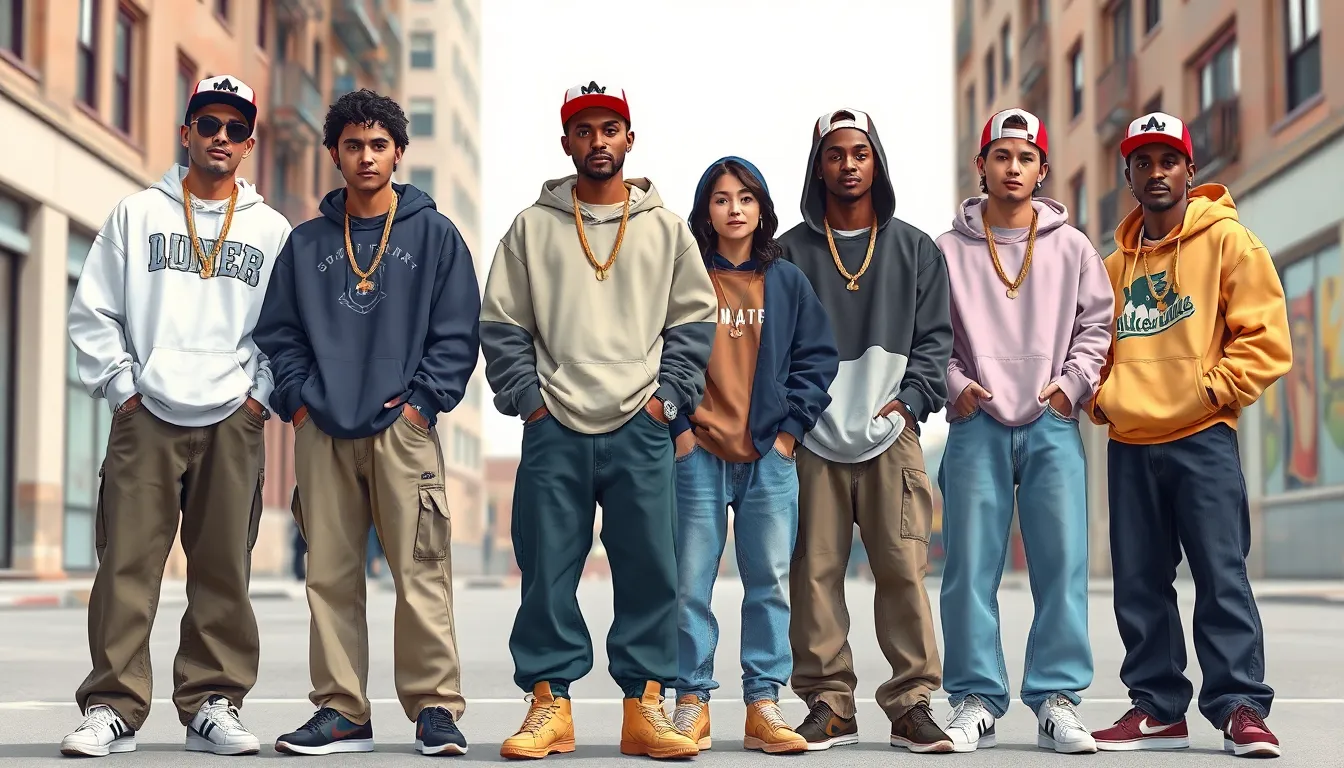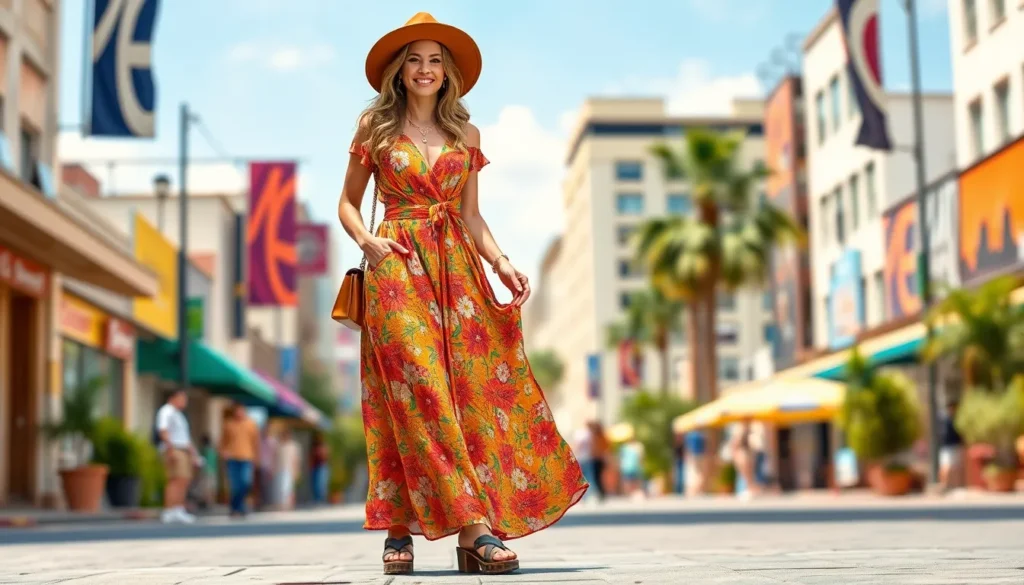Step back in time to the early 2000s, when hip hop fashion ruled the streets like a king on a throne. Baggy jeans, oversized tees, and bling that could blind a magpie defined a generation. It was a time when style wasn’t just about looking good; it was about making a statement loud enough to drown out the latest pop hits.
Early 2000s Hip Hop Fashion
Early 2000s hip hop fashion made a significant impact on streetwear culture. Baggy jeans became a staple, often worn several sizes larger than traditional fits. Oversized tees adorned with bold graphics and logos complemented these pants, creating a loose and relaxed silhouette. Sneakers, especially brands like Nike and Adidas, played a crucial role in completing the outfit, with many styles showcasing bright colors and unique patterns.
Accessories added a distinct flair to these looks. Baseball caps, usually worn backwards, and thick gold chains accentuated the vibe. Statement pieces, including large hoop earrings and sunglasses, became essential components of this style, reflecting confidence and attitude. Tracksuits, particularly those from brands like Sean John and FUBU, gained popularity for their comfort and eye-catching designs.
Men and women alike embraced this fashion, creating a unique unisex style. For women, the trend also included low-rise jeans and crop tops, which emphasized their figures while retaining the overall baggy aesthetic. Footwear choices expanded to include chunky sneakers and platform shoes, catering to a diverse audience.
Cultural figures further influenced fashion trends. Artists like Lil’ Wayne and Missy Elliott set the standard, with their unique garments often leading to widespread adoption. Music videos served as a runway, showcasing the latest looks and encouraging fans to emulate their favorite stars.
Overall, early 2000s hip hop fashion not only became a voice for self-expression but also established a legacy that continues to inspire today’s streetwear trends.
Key Trends In Early 2000s Hip Hop Fashion

Early 2000s hip hop fashion features distinct elements that captured the spirit of the era. Each trend reflects a unique blend of style and culture.
Baggy Clothing
Baggy clothing dominated this period, providing comfort and a relaxed aesthetic. Baggy jeans became a staple for both men and women, often worn several sizes larger than the wearer’s actual size. Loose-fitting tees with bold graphics complemented this silhouette. Streetwear often included oversized hoodies, popular for their casual vibe. Many artists embraced this style, solidifying its significance in hip hop culture, which emphasized individuality and self-expression.
Customization And Personalization
Customization and personalization played vital roles in early 2000s fashion. Many individuals customized their apparel by adding patches, pins, or unique designs. Custom sneakers gained popularity, allowing fans to express their favorite affiliations or personalities. Some wore jerseys from their favorite athletes, featuring personalized embroidery or embellishments. This emphasis on individuality made clothing a canvas for personal expression and creativity.
Signature Accessories
Signature accessories defined early 2000s hip hop fashion, elevating styles to new heights. Thick gold chains and oversized earrings became essential components of any outfit. Backward baseball caps, often featuring logos, added a playful edge to casual looks. Sunglasses with large frames complemented bold outfits, providing an air of swagger. These accessories not only stood out but also contributed to the overall statement of confidence and style prevalent in hip hop culture.
Influential Artists And Their Styles
Early 2000s hip hop fashion drew considerable inspiration from prominent artists, each showcasing unique styles that shaped the era’s aesthetic.
The Impact Of Eminem
Eminem revolutionized hip hop fashion with his distinct look, often characterized by baggy jeans, oversized graphic tees, and hoodies. He popularized the “slim-shady” aesthetic, emphasizing a rebellious attitude through his outfits. Accessories like beanies and large silver chains became synonymous with his style. Concert performances and music videos featured bold color contrasts, amplifying his image. His influence resonated with fans, prompting a wave of emulation among youth who sought to replicate his signature looks. The rapper’s willingness to challenge norms fostered a culture of creativity in fashion that extended beyond his immediate fanbase.
The Influence Of Jay-Z
Jay-Z’s style represented sophistication blended with street sensibility, promoting tailored suits and designer brands. He introduced formal elements into hip hop, wearing high-end labels alongside casual streetwear staples. Signature pieces included fitted caps, crisp white sneakers, and luxury watches, showcasing a balance of elegance and urban flair. The rapper’s fashion choices in music videos often reflected his status, encouraging fans to embrace a more polished aesthetic. Collaborations with brands like Rocawear set trends that emphasized quality and style, bridging the gap between hip hop culture and mainstream fashion. Jay-Z’s influence pushed the boundaries of hip hop fashion into new territories, establishing a legacy of refined urban style.
Cultural Significance Of Early 2000s Hip Hop Fashion
Early 2000s hip hop fashion transcended mere clothing choices, embodying a cultural movement that celebrated individuality and self-expression. This period marked the fusion of music and fashion, with streetwear emerging as a dominant force in the industry. Notably, hip hop style influenced mainstream fashion, as designers adopted elements like oversized silhouettes and bold graphics, connecting urban style to larger fashion narratives.
Significant cultural figures played pivotal roles in shaping these trends. For instance, artists such as Lil’ Wayne and Missy Elliott became fashion icons, using music videos to showcase cutting-edge looks that resonated with fans. Their influence extended beyond the music scene, inspiring everyday fashion choices and encouraging a sense of community among fans.
Everyday wear transformed into a statement of identity during this time. Baggy jeans and oversized tees provided comfort while promoting a laid-back attitude. Accessories such as thick gold chains and oversized sunglasses defined the aesthetic, contributing to a confident persona that resonated within the culture.
Customization emerged as a crucial element, allowing individuals to personalize their apparel. Custom sneakers and uniquely designed jerseys highlighted personal style, creating a sense of individuality among fans. This level of personalization showcased a rebellion against uniformity, enhancing the cultural significance of hip hop fashion.
Streetwear brands like Sean John and FUBU became synonymous with the movement, offering designs that appealed to diverse demographics. Their popularity helped solidify the unisex nature of early 2000s fashion, further emphasizing the cultural blend within hip hop scenes. This era ultimately carved out a legacy that continues to inspire contemporary streetwear trends, illustrating the lasting impact of early 2000s hip hop fashion on modern style.
Conclusion
Early 2000s hip hop fashion was more than just a trend; it was a powerful expression of identity and creativity. The era’s distinctive styles and bold choices shaped not only the music scene but also the broader landscape of streetwear culture. Artists like Eminem and Jay-Z pushed boundaries, blending comfort with high fashion and inspiring countless fans to embrace their unique styles.
The legacy of this vibrant fashion period continues to influence today’s trends, reminding everyone of the importance of self-expression through clothing. As contemporary streetwear evolves, the spirit of early 2000s hip hop fashion remains alive, proving that true style transcends time and continues to inspire future generations.



